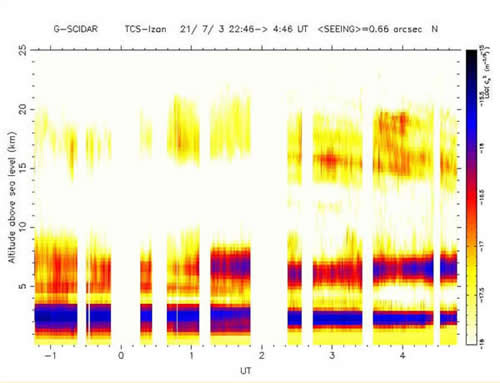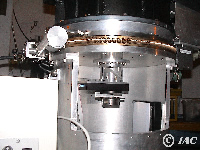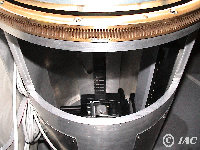.
An instrument using the Generalized-SCIDAR technique, which we have called cute-SCIDAR, has been developed
at the IAC, providing high performances in automatic
control and data reduction. It has been designed for the Jacobus
Kapteyn Telescope (Fig. 1) at the Roque de los Muchachos Observatory,
with the goal of monitoring the vertical turbulence with a high
temporal coverage. This instrument is providing data from February 2004, with the frequency of 4-6 nights per month, coinciding with new moon periods. The concept and technique come from the original one developed in the 90's by Jean Vernin, Max Azouit and collaborators at Nice University (Fig. 2).
Subsequently, other instrument has been developed for the Carlos Sánchez Telescope (Fig. 3) at the Teide Observatory. This instrument arranges two branches, one of them is a replica of the cute-SCIDAR in JKT (Fig. 4), and the other one is a Shack-Hartmann sensor (Fig. 5). A beam splitter directs part of the beam to both branches.
.
|
 Fig.
9.- Output of the post-processing of the cute-SCIDAR data. The X and Y axis are the Universal Time (h) and the altitude above the sea (km) respectively. The color palette gives the intensity of the turbulence (Cn2) in logarithmic scale. Each individual profile permits to get the total seeing, isoplanatic angle or whatever centile of the altitude of the turbulence you wish. In the post-proccessing, the contribution of the dome seeing is discarded.
Fig.
9.- Output of the post-processing of the cute-SCIDAR data. The X and Y axis are the Universal Time (h) and the altitude above the sea (km) respectively. The color palette gives the intensity of the turbulence (Cn2) in logarithmic scale. Each individual profile permits to get the total seeing, isoplanatic angle or whatever centile of the altitude of the turbulence you wish. In the post-proccessing, the contribution of the dome seeing is discarded. |
|
| .
Generalized-SCIDAR technique has proved to be the most efficient to obtain optically the
vertical structure of the atmospheric turbulence measured
from ground level. However, the common procedure of obtaining
the data, as well as its 'a posteriori' processing, requires
a huge number of highly qualified human resources. A systematic
monitoring programme becomes really onerous. Consequently, the
development of a full automatically controlled SCIDAR device
seems to be evidently justified. .
REQUIREMENTS
AND SPECIFICATIONS
The generalized-SCIDAR technique uses the scintilation produded by the light from a binary star when pass through the turbulence. Then, it requires to position the camera in different distances from the exit pupil in order to change the observing conjugated plane. On the other hand, the alignment of the components of the star must coincide with the direction of the columns or rows of the CCD. Therefore, the
control mechanisms are fixed: a) by the positioning of the
camera in the conjugated plane of detection and the optical
axis, and b) by the rotation of that plane to orient the separation
of the binary star with the rows of pixel of the detector.
a)
The camera is lodged in two devices that give the movement
in XY, which allows correcting small displacements in the
observation plane produced by flexion. Movement Z (optical
axis) is provided by a long electronic-rail (Fig. 7) that, besides
to position the camera in the observation plane, facilitates
the procedure of focusing of the instrument, since it permits
to verify easily with a single star the state of collimation
of the beam. The maximum range in XY is 25 mm and in Z it
is of 300 mm.
b)
The rotation of the plane is generated turning the complete
instrument with respect to the telescope (Fig. 6). The range of total
turn is 270º, and it is transmitted through a crown wheel.
Another
complementary mechanism is an iris, placed in the focal plane
(see the scheme of Figure 2), also electronically controlled.
In Fig. 6, the device of the iris and the collimator are beholden,
within the body of the instrument,. In Fig. 7,
the crown wheel is perceived in first plane and to the bottom
the camera with its support attached to the rail on which it runs.
.
|
 Fig.
6.- Upper
part of the cute-SCIDAR instrument in JKT. The engine and spin transmission
are seen.
Fig.
6.- Upper
part of the cute-SCIDAR instrument in JKT. The engine and spin transmission
are seen. |
 Fig.
7.- Inner view with the camera of the cute-SCIDAR instrument in JKT. In the first plane, the crown is seen.
Fig.
7.- Inner view with the camera of the cute-SCIDAR instrument in JKT. In the first plane, the crown is seen. |
|
.
A
specific software package for the control of the devices,
acquisition and data pre-processing has been developed. On
the other hand, one user-friendly interface based on windows
allows handling all the controls. In Fig. 8, we show a screen with
windows of the user interface. It gives the raw image and the autocorrelation function, as well as plots to check the signal-to-noise ratio. The post-processing code provides the temporal evolution of the vertical distribution of the Cn2 (Fig. 9) without the contribution of the dome seeing. It permits to get several important parameters, such as the total seeing, the isoplanatic angle and whatever centile of the altitude of the turbulence, as well as temporal statistics. Using the cross-correlations among the succesive images, the velocity of the turbulence layers can be approached, and therefore to calculate the characteristic time of the turbulence. All these parameters are crucial as for site characterization as for the optimum design and efficient operation of AO/MCAO systems.
CONCLUSIONS
The
high cost of resources that entails the monitoring of the
turbulence with quite height resolution justifies the development
of an instrument that diminishes these constraints. The plan
of a long campaign of measurements of the vertical structure
of the turbulence in the Roque of Muchachos and Teide observatories
has encouraged to us to built an instrument with high performances
and minimal operational efforts. Cute-SCIDAR is an automatically
controlled instrument. This means a complete automation of
both displacement of optical elements and rotation of the
instrument itself. These movements are controlled by a user-friendly
interface. Moreover, this custom-made software package performs
fast data acquisition and processing. As a consequence, alignment
and observation procedures reduce to easy handling and without
the effort operating in the dome. These lead to a high temporal
profit during the observation campaign. |
| |
--0-- |
The development of the two instruments and the observing procedures have been carried out by Jesús J. Fuensalida (PI), Claudia Hoegemann, Jose Miguel Delgado, Begoña García-Lorenzo, Ángeles Rodríguez-Hernández, Marcos Reyes, Manuel Verde, Elvio Hernández, with the IAC Mechanical workhop and Electronics Workshop.
The Jacobus Kapstein Telescope is operated by the Isaac Newton Group at the Observatorio del Roque de los Muchachos (island of La Palma). The Carlos Sánchez Telescope is operated on the island of Tenerife (Observatorio del Teide) by the Instituto de Astrofísica de Canarias. We thank all the staff at the observatories for their kind support.
This research has been supported partially by the Spanish Plan Nacional de Astrofísica under grant AYA2003-07728.
. |
|
|

 ....
.... 
 ....
....